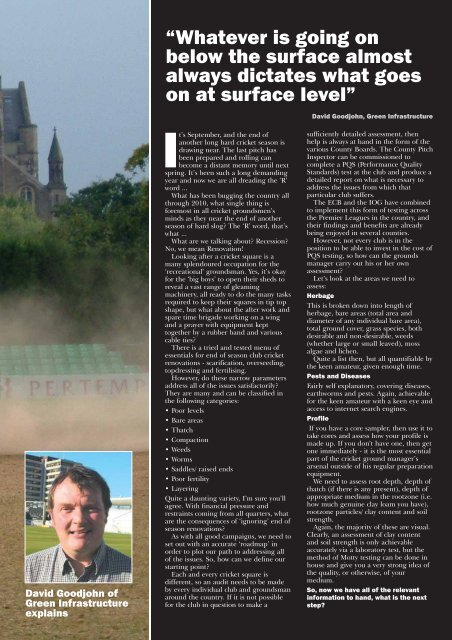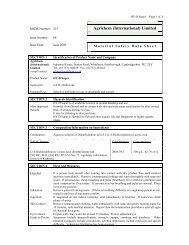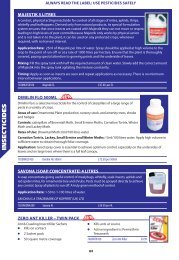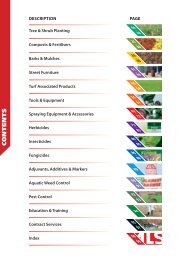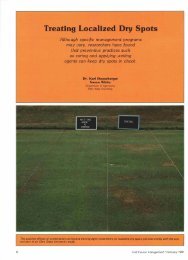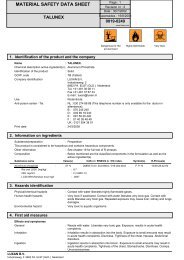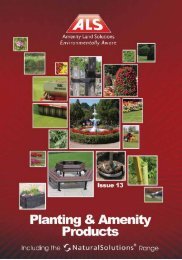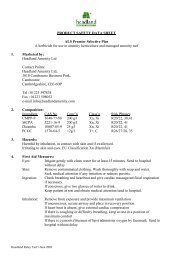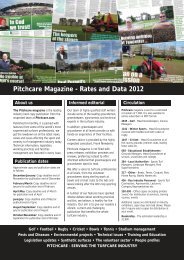Marshalling his troops - Pitchcare
Marshalling his troops - Pitchcare
Marshalling his troops - Pitchcare
You also want an ePaper? Increase the reach of your titles
YUMPU automatically turns print PDFs into web optimized ePapers that Google loves.
David Goodjohn of<br />
Green Infrastructure<br />
explains<br />
“Whatever is going on<br />
below the surface almost<br />
always dictates what goes<br />
on at surface level”<br />
It’s September, and the end of<br />
another long hard cricket season is<br />
drawing near. The last pitch has<br />
been prepared and rolling can<br />
become a distant memory until next<br />
spring. It’s been such a long demanding<br />
year and now we are all dreading the ‘R’<br />
word ...<br />
What has been bugging the country all<br />
through 2010, what single thing is<br />
foremost in all cricket groundsmen’s<br />
minds as they near the end of another<br />
season of hard slog? The ‘R’ word, that’s<br />
what ...<br />
What are we talking about? Recession?<br />
No, we mean Renovation!<br />
Looking after a cricket square is a<br />
many splendoured occupation for the<br />
‘recreational’ groundsman. Yes, it’s okay<br />
for the ‘big boys’ to open their sheds to<br />
reveal a vast range of gleaming<br />
machinery, all ready to do the many tasks<br />
required to keep their squares in tip top<br />
shape, but what about the after work and<br />
spare time brigade working on a wing<br />
and a prayer with equipment kept<br />
together by a rubber band and various<br />
cable ties?<br />
There is a tried and tested menu of<br />
essentials for end of season club cricket<br />
renovations - scarification, overseeding,<br />
topdressing and fertilising.<br />
However, do these narrow parameters<br />
address all of the issues satisfactorily?<br />
They are many and can be classified in<br />
the following categories:<br />
• Poor levels<br />
• Bare areas<br />
• Thatch<br />
• Compaction<br />
• Weeds<br />
• Worms<br />
• Saddles/ raised ends<br />
• Poor fertility<br />
• Layering<br />
Quite a daunting variety, I’m sure you’ll<br />
agree. With financial pressure and<br />
restraints coming from all quarters, what<br />
are the consequences of ‘ignoring’ end of<br />
season renovations?<br />
As with all good campaigns, we need to<br />
set out with an accurate ‘roadmap’ in<br />
order to plot our path to addressing all<br />
of the issues. So, how can we define our<br />
starting point?<br />
Each and every cricket square is<br />
different, so an audit needs to be made<br />
by every individual club and groundsman<br />
around the country. If it is not possible<br />
for the club in question to make a<br />
David Goodjohn, Green Infrastructure<br />
sufficiently detailed assessment, then<br />
help is always at hand in the form of the<br />
various County Boards. The County Pitch<br />
Inspector can be commissioned to<br />
complete a PQS (Performance Quality<br />
Standards) test at the club and produce a<br />
detailed report on what is necessary to<br />
address the issues from which that<br />
particular club suffers.<br />
The ECB and the IOG have combined<br />
to implement t<strong>his</strong> form of testing across<br />
the Premier Leagues in the country, and<br />
their findings and benefits are already<br />
being enjoyed in several counties.<br />
However, not every club is in the<br />
position to be able to invest in the cost of<br />
PQS testing, so how can the grounds<br />
manager carry out <strong>his</strong> or her own<br />
assessment?<br />
Let’s look at the areas we need to<br />
assess:<br />
Herbage<br />
T<strong>his</strong> is broken down into length of<br />
herbage, bare areas (total area and<br />
diameter of any individual bare area),<br />
total ground cover, grass species, both<br />
desirable and non-desirable, weeds<br />
(whether large or small leaved), moss<br />
algae and lichen.<br />
Quite a list then, but all quantifiable by<br />
the keen amateur, given enough time.<br />
Pests and Diseases<br />
Fairly self explanatory, covering diseases,<br />
earthworms and pests. Again, achievable<br />
for the keen amateur with a keen eye and<br />
access to internet search engines.<br />
Profile<br />
If you have a core sampler, then use it to<br />
take cores and assess how your profile is<br />
made up. If you don’t have one, then get<br />
one immediately - it is the most essential<br />
part of the cricket ground manager’s<br />
arsenal outside of <strong>his</strong> regular preparation<br />
equipment.<br />
We need to assess root depth, depth of<br />
thatch (if there is any present), depth of<br />
appropriate medium in the rootzone (i.e.<br />
how much genuine clay loam you have),<br />
rootzone particles/ clay content and soil<br />
strength.<br />
Again, the majority of these are visual.<br />
Clearly, an assessment of clay content<br />
and soil strength is only achievable<br />
accurately via a laboratory test, but the<br />
method of Motty testing can be done in<br />
house and give you a very strong idea of<br />
the quality, or otherwise, of your<br />
medium.<br />
So, now we have all of the relevant<br />
information to hand, what is the next<br />
step?


